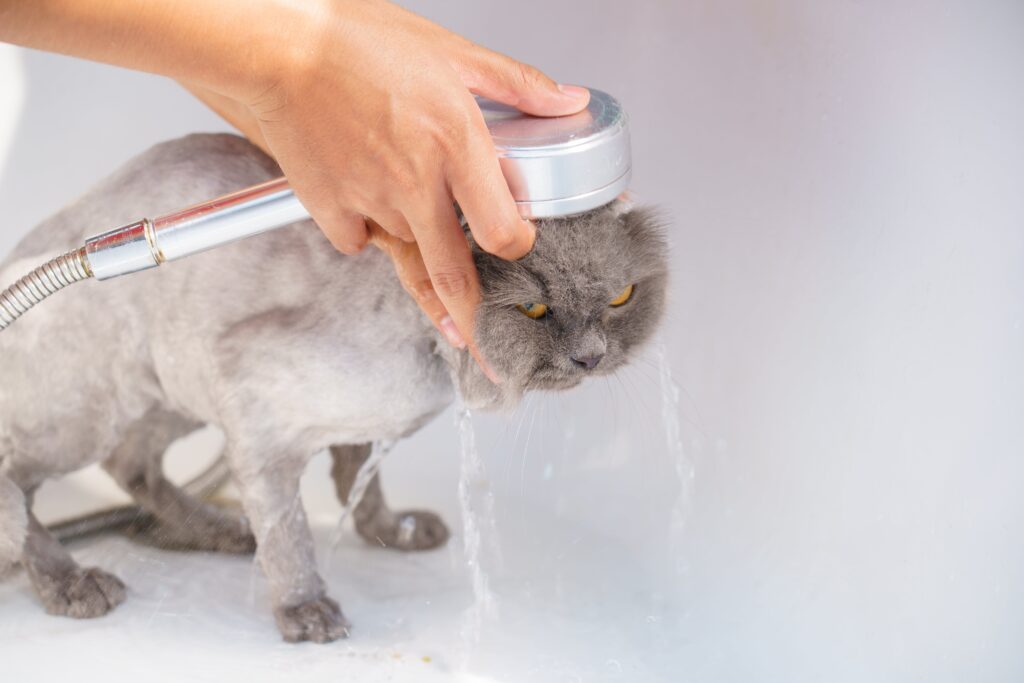Bathing your feline friend can be a challenging task because most cats dislike water. However, there are situations where a bath becomes necessary, such as if your cat gets into something sticky or toxic, or if they have a medical condition that requires bathing.
You can bathe your cat in a bathtub, kitchen sink, or bathroom sink. A sink with a gentle spray nozzle is easier on your back and gives you more control. You can also use an unbreakable cup to pour water over your cat.
Whether it’s your first time owning a tabby or not, you have to take note of some important things before you start the bathing process.
Before you begin, make sure to gather all supplies within arm’s reach:
- Cat-friendly shampoo (preferably one recommended by your vet).
- Towels for thoroughly drying your feline friend, of course.
- Rubber mat or a towel for the bottom of the sink or tub to prevent slipping.
- A cup or handheld sprayer for wetting and rinsing.
- Treats for positive reinforcement.
- Close the doors – if your tabby is a runner, it’s best that you close your bathroom door to prevent escapees.
- Trim Nails – This isn’t really necessary, but trimming your kitty’s nails before bath reduces the risk of scratches.
How to Safely Bathe Your Feline Friend

Now that all is ready and set here are some tips for safely bathing your feline friend:
- Brush your tabby: Brush your cat to remove loose fur and mats. This can help reduce hairballs and make the bathing process smoother.
- Getting your cat wet: Gently place your cat in the water, supporting their body but allowing their feet to touch the bottom.
- Water temperature: Always check the water temperature before placing your cat in the bath. The water should be lukewarm, not too hot and not too cold.
- Water level: If you’re planning to give your feline friend a nice and relaxing time at the tub, make sure to check the water level. Ensure that the water level is not too deep.
- Shampoo: Use a cat-safe shampoo and dilute it according to the manufacturer’s instructions. You can also use a soft brush or washcloth to apply the shampoo. This way you can thoroughly and gently scrub the shampoo.
- Rinsing: Rinse your cat thoroughly until their coat is clean. You can rinse your cat three times to remove soap. The residual shampoo in the coat can irritate your feline friend’s skin. You can use a cup or handheld sprayer, and be gentle to avoid stressing your cat.
- Face: Avoid getting water in your cat’s eyes, nose, and ears. You can use a damp washcloth to clean their face. Soap can burn or irritate your kitty’s eyes and nose, and damage their eardrums.
- Rectal area: Avoid rubbing your cat’s rectal area.
- Drying: Wrap your cat in a towel and dry them vigorously. Gently pat them dry. Some cats tolerate blow drying on a low, cool setting.
Tips on How to Make Your Feline Friend Love Bath Time
- Stay Calm: Cats can pick up on your emotions. If you’re calm, it may help keep your cat more relaxed.
- Be Patient: If your cat becomes stressed, take breaks and try to soothe them.
- Gradual Introduction: If your cat is not used to baths, introduce them gradually to the idea of water by letting them explore an empty tub or sink.
- Pre-Bath Positive Reinforcement: Before starting, you can give cat treats and positive attention near the bathing area so that your feline friend can associate something good before bathing.
- Post-Bath Treats and Praise: Reward your fur baby with treats and praise after the bath to create positive associations.
How Often Do Cats Need to Take a Bath?
Our feline friends are known to independently groom themselves due to their rough tongues. However, they still need a bath occasionally, especially when exposed to debris like mud, sap, and excess dirt. So if your kitty usually stays outdoors and likes to explore nature, they will probably need more frequent bathing than an indoor cat.
According to the National Cat Groomer’s Institute, receiving a bath once every 4 to 6 weeks will work for most cats. As a rule of thumb, it’s smart to bathe your feline companion when needed. If you notice something smelly in your cat’s fur, for instance, take the opportunity to wash them.
Bathing your cat too often can dry out their skin, so use your best judgment to decide when it’s time for a bath.
In addition, according to Dr. Alison Diesel, a clinical associate professor at the Texas A&M College of Veterinary Medicine & Biomedical Sciences. “In general, cats do not need to be given a bath by their owners,” she said. “Their fastidious grooming behavior makes this a non-necessary task, which most owners are quite thankful for.” However, this is not the case for Sphynx cats. Feline’s coat draws oils away from the skin and is rid away when they groom themselves. Since, our hairless feline friends don’t have a coat, grooming alone is not sufficient to rid of oils in their skins. Hence, they require bathing as part of their routine skin care, at least once a week.
Remember, not all cats need regular baths, and it’s essential to consider your cat’s individual temperament and health. If you’re unsure about bathing your cat or if they have specific skin conditions, consult with your veterinarian for guidance or you can go to a local professional groomer.













